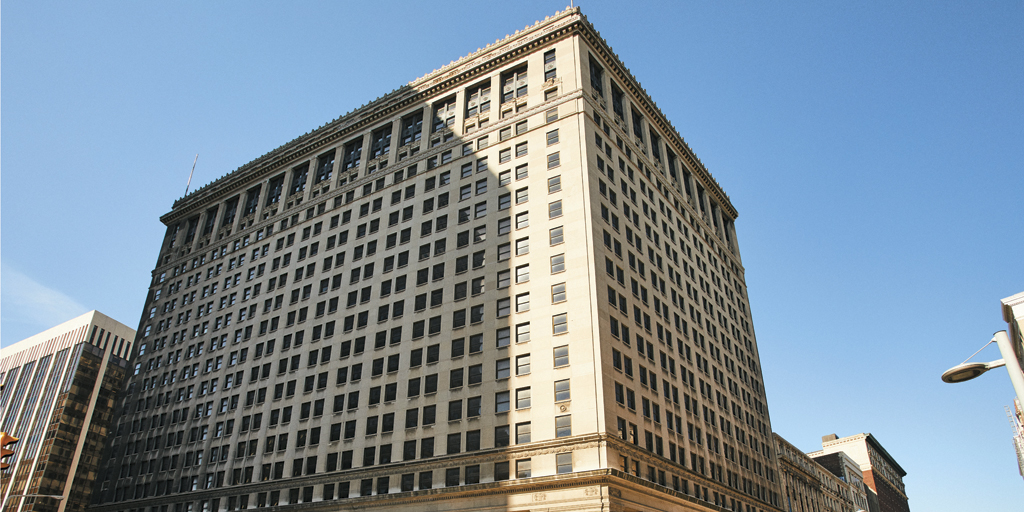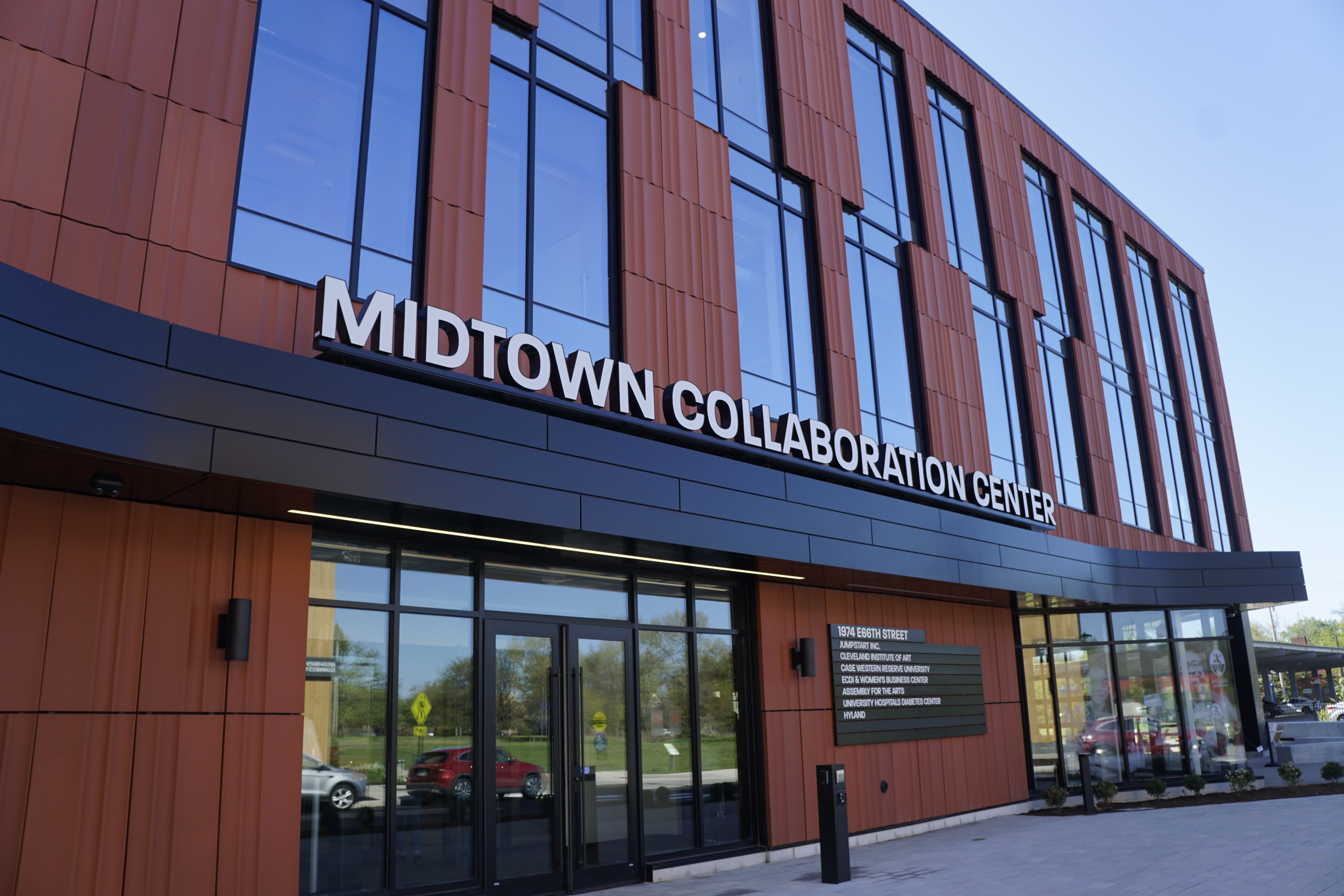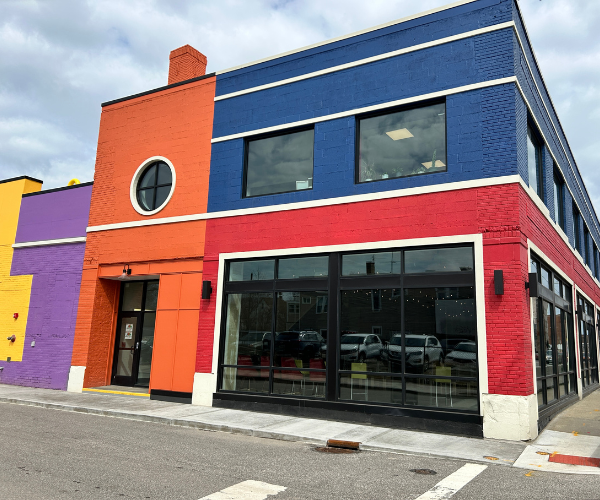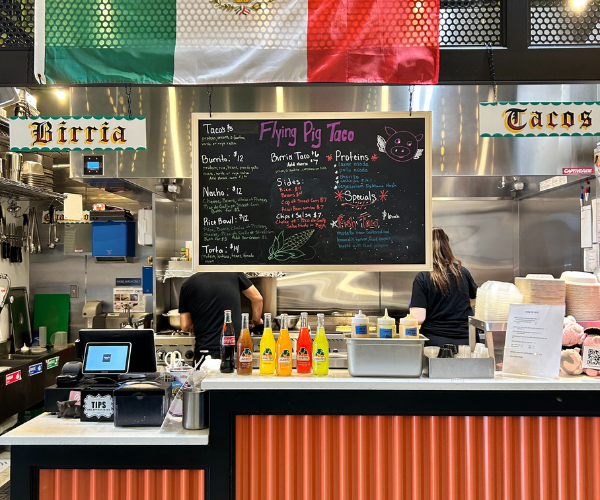Banking on Downtown
by Sheehan Hannan | Aug. 13, 2018 | 12:00 PM

Kevin Kopanski, Rob Dobi
For two people in the development business, Frank and Malisse Sinito are a study in juxtaposition.
Frank is all business in a gray suit and gunmetal glasses. Malisse is the more casual of the pair, donning a flower-pattern top and lugging a large purse.
After brief introductions, they bundle into an elevator for a tour of the massive lobby of the 925 Building. On the third floor, they lead me to the balcony that encircles the L-shaped lobby. “This building, every time I come here, the beauty is just …” Frank says, trailing off as we reach the railing and letting the space speak for itself.
The banking lobby overwhelms you with marble — floors, columns, even the intricately carved banking tables. The floor, vast as a football field, tends to squeak undershoe. All around, rows of Corinthian columns support a barrel-vaulted ceiling high above, modeled on a Roman basilica.
As we circle the lobby, it’s evident the original builders, the Union Trust bank, the largest bank outside New York in the 1920s, intended this space to trumpet a company and city bound for new heights of prosperity.
Far above, faint light teases the faded colors of Grecian-inspired murals. One shows Lady Liberty, flanked by two rifle-toting doughboys standing at attention. Each of her hands grasps a pole, from atop which American flags billow. She glows with freedom everlasting, heavenly, framed by a corona of red, white and blue. She stares down bare-breasted and proud.
It’s that kind of place.
Rounding the long side of the L, Frank again stands at the railing. He looks down on a grand staircase and a creamy carpet stretching toward what will eventually be the entrance to hotel rooms, offices, a restaurant and a car showroom.
“This is one of the draws that initially drew me to this project,” Frank says. “Look at this. It’s just beautiful.”
The Union Trust folded less than a decade after the building was completed in 1924, cast aside like a crumpled dollar bill in the breeze. But the lobby, and the high-flying dream for Cleveland it embodied, remained.
Lately, it’s mostly sat empty, except for an occasional wedding. The lobby’s plaster ornamentation is crumbling and cracking in places from moisture.
Just as the East Ninth Street and Euclid Avenue intersection is important for Cleveland, this moment is a significant crossroads for the Sinitos. Over the last five years, the husband and wife team have quietly emerged as two of downtown’s biggest real estate players.
In 2014, their privately controlled Millennia Cos. purchased 75 Public Square, their first center-city foray. The next year, they scooped up the Garfield Building at East Sixth Street and Euclid Avenue and transformed its former National City banking lobby into Marble Room, a swanky steak and seafood restaurant.
But those properties were just the foundation for the Sinitos’ major real estate play downtown. In January 2017, Millennia acquired the iconic Key Tower, Ohio’s tallest skyscraper, for $267.5 million. In May, the company scooped up the 925 Building for $40 million.
In the short end of the 925’s L, they are contemplating another high-end restaurant with a menu tilted toward Asian cuisine. On the L’s other end, if negotiations pan out, a luxury car showroom could be outfitted with gleaming Bentleys and Aston Martins.
They expect the 925 Building to be a showpiece in an evolving downtown, just as it was when it was built.
“It seems like [Frank] is trying to build some legacy in the city center,” says downtown councilman Kerry McCormack. “No doubt about it.”
But the Sinito name already comes with a bit of history. Frank’s father, Thomas Sinito, was a notorious Cleveland mobster. Imprisoned during his son’s high school years, Thomas found religion behind bars. After his father’s death, Frank too was converted and founded Ohio’s largest prison ministry.
Although he is often quoted in the business press, Frank has never told a reporter his father’s story. It’s part of what I want to know, but Frank is elusive, constantly on the move.
We circle the lobby, then duck into a set of C-suite offices, where Frank and Malisse check out a boardroom and look out over Ninth and Euclid.
“This is the one project that has to get done,” Frank says. “You can’t have this renaissance occurring here in Cleveland without this building getting done.”
We zip downstairs to see the vault and then step out into the Euclid Avenue heat. Over the last few years, the gaps up and down the block have slowly filled in — Heinen’s Grocery Store in the Cleveland Trust building, renovations and a Yours Truly at the Halle Building. Even the long-troubled Cleveland Athletic Club, which used to radiate mildew stink and cold breezes onto the sidewalk, is abuzz with construction equipment.
The Sinitos are late arrivals to downtown’s revival. The pioneer work is done. Others cleared the brush and paved the streets. Last year, the neighborhood added more than 800 units of housing and hit 15,000 residents, a significant milestone on the quest toward 20,000.
“I mean, truly, we are Johnny-come-lately,” Frank says, spreading his arms up and down the street to indicate his new neighbors as he walks toward the Statler, Millennia’s latest acquisition. “They get all the tribute.”

A sign on the sidewalk outside the Statler proclaims “New Owner! New Lifestyle!”
The Sinitos walk through a door and past the desk of a leasing agent, where a man and a woman share the mildly apprehensive look of two young people moving in together.
Millennia purchased the Statler in January for $40 million and is in the midst of a $13 million renovation to upscale the building into luxury apartments. That means glitzier surroundings, such as a restaurant in the former Swingos at the Statler space in the back of the building, but also higher rents.
“We are very excited about creating workforce housing at 925, ‘cause we feel really bad because of the folks that won’t be able to afford the new rents,” says Frank, as he enters the lobby. “We’re going to create really great affordable housing within 925.”
Although many associate the company with upscale living and dining, most of Millennia’s portfolio, about 80 percent, is rented at affordable rates. In the 925 Building’s annex, the Sinitos plan for around 200 apartments to serve lower-income residents working downtown.
My coworker who lives in the building wants to know why rent is going up, so I ask.
“Pardon?” Frank says.
I repeat the question and chuckle to cut the tension, but it is awkward.
Frank grimaces and pivots toward a glass-walled conference room.
“This is the construction and design team,” Frank says, guiding me to where a group of about 10 sit around a table.
When I look up from taking a few notes, I’m in a conference room full of people, but Frank has deserted me.
After a few moments, Malisse retrieves me, and we walk down the street to Marble Room.
Married in 1988 after a family fix-up, the couple splits the business. As president of Millennia Hospitality Group, Malisse manages the company’s restaurants, including Marble Room, LockKeepers and Il Venetian, plus the event facility at Key Tower, the St. Clair Ballroom. Frank oversees the real estate.
Malisse, a Baldwin Wallace University graduate who cut her teeth working part-time restaurant industry jobs in the Flats, swings open the door to Marble Room. Between the long rows of pink Italian marble columns, the Sinitos have transformed the former National City banking hall into Cleveland’s most opulent restaurant.
“You see the similarities, right?” says Malisse. “But this is just way over the top.”
Shimmering chandeliers hang from gilded ceilings. A quartz bar stretches along one side with a glass-enclosed wine bottle refrigerator housing some 1,600 bottles overhead. Some of the bank’s former check-writing tables are repurposed as high-tops, set among plush velvet banquettes and leather chairs.
Every detail is cared for. Subtle acoustic paneling on the walls and strategically placed curtains even cut down on the echoes one might expect in a room made almost entirely of marble.
The food is just as meticulous. Lobster, oysters, shrimp and Dom Perignon all rest in a bed of chipped ice on the raw bar.
Malisse expects to take some pointers from Marble Room for the restaurant space at the 925 Building, she says, but she is still in the planning stages. She and Frank have sampled Buddha Bar, a restaurant and hotel concept that’s expanded internationally, and Tao in Las Vegas, both known for their opulent Asian stylings, for inspiration.
“It’s got to fit the space. I don’t know what that means yet,” she says, leading me into the second bank vault of the day.
Downstairs, the anteroom and vault are set up as a private dining room and bar, more intimate than upstairs but just as luxe. Jon Bon Jovi ate there before this year’s Rock & Roll Hall of Fame induction ceremony, says Malisse.
“No matter where they come from, when they come in here to this building, they’re like ‘Whoa,’ ” she says. “People from literally all over the world walk in and go, ‘Oh my God.’ ”

Frank Sinito leans against the bar in the St. Clair Ballroom, legs crossed, leaning on his elbows.
He has a story for a group of developer types, drinks in hand. Roughly 20 have been invited to the informal gathering to share wisdom, drinks and socialize.
An ad for Key Tower loops on a television behind the bar. It features a handsome businessman enjoying the tower’s new health center, restaurants and public spaces. They didn’t go far for casting. It’s the eldest Sinito son, Frank Jr.
“I started out the hard way,” Frank says. He bought his first apartment building in 1985 on Madison Avenue in Lakewood. “Twelve residential units, two commercial units,” he continues. “I could probably recite the rent on all.”
Frank was attending Cleveland State University at the time. He paid his way with a job at the rough-and-tumble Little Ange’s River Pub in Valley View, an establishment named, for a time, after a mob associate. He’d worked there since high school.
Frank bought shares in the business, then the entire thing, from an aunt who owned the place. Frank and Malisse worked there together, slinging drinks from behind the bar.
In 1992, they renovated the River Pub into LockKeepers, transforming the building from what a Plain Dealer critic once called “a dumpy-looking biker’s bar” into an upscale dining destination with handmade pastas and a bustling lunch.
“My wife’s running this shot-and-beer tavern. I said, ‘OK, this isn’t good anymore,’ “ Frank says. “We created LockKeepers because I needed a venue where I would feel comfortable with my wife working in.”
Income from LockKeepers financed an expansion in their real estate holdings. By 1995, the two incorporated Millennia Housing Management with about 1,500 units.
But even as the company grew, it avoided Cleveland. Early in the administration of Mayor Michael White, Frank tells the developers, a close associate of the mayor, Nate Gray, approached him about a window contract. Gray allegedly wanted a $50,000 order. Frank refused.
Gray was convicted of bribery connected to East Cleveland Mayor Emmanuel Onunwor in 2005. The FBI suspected Gray was White’s bagman in an extortion scheme. White was never charged and has steadfastly denied the allegation.
“I really couldn’t do anything in Northeast Ohio during that entire tenure, while Mayor White was in office,” Sinito tells the developers. “He sent a message through Nate Gray.”
Millennia turned elsewhere, snapping up properties throughout the eastern half of the United States. Millennia owns almost 30,000 housing units in 26 states and employs about 1,700. Last year, Affordable Housing Finance magazine ranked the company as the third-largest owner of affordable housing in the country.
Even so, Millennia and the Sinitos ran under the radar in Cleveland. But everything changed with the purchase of Key Tower.
The $267.5 million deal was a mammoth effort, Sinito says. From July 2016 to closing in January 2017, his only day off was Christmas. Extensive renovations to the lobby have since created a destination for dining, including a sushi bar, gelato stand and Il Venetian, an upscale Italian restaurant. Millennia moved its local offices from the suburbs to the tower’s 40th floor.
Although only 55, Frank has recently started speaking about Millennia as a generational business, something to pass on to his sons.
But there will be much time, and another huge renovation to complete, before that happens. Indeed, overhauling the 925 Building may be the hardest project he’s ever worked on, Frank concludes. For that, he may need liquid courage.
“I’m going to have a martini after this,” he says, wryly, “at Il Venetian.”
--
Chandeliers hang above a dining room furnished with rich leather chairs and plush banquettes. Bottles of wine glisten in a glass-enclosed case to one side.
I claim a table with Malisse and catch a glimpse into Il Venetian’s gleaming kitchen where a crew of cooks craft pastas by hand.
As Frank walks toward his chair after his speech, he seems to know what I’d like to ask him. “Did you take notes when I was speaking?” he asks.
“I did, yeah,” I reply.
“So you know the whole …” he says.
“I have some questions regardless,” I say.
“Very few,” he says.
Frank pulls a piece of paper covered in numbers from his coat and places it in front of Malisse. “Our friends at Forest City,” he says. Last year, the storied realty trust moved out of its offices at Terminal Tower and into Key Tower.
They murmur about the figures and then speak to each other as if I am not there. “He heard my whole story,” Frank says to Malisse, looking down at his phone. “I don’t have to talk to him.”
Frank orders that martini. I ask a few questions, and he gives terse answers, texting all the while on his phone.
Across the restaurant, he sees a KeyBank executive with whom he often does business. A few minutes later, Frank leaves our table to speak with her.
He answers a few more queries when he returns. But it comes time to order, and he is thumbing his phone again.
I take a breath and ask the question, the one about his father.
“How did you find your faith?” I ask.
“Let me …” he says, still typing on his phone.
“I’m sorry,” I say.
The subject quickly changes as Malisse points out their youngest son, Tommy, bustling around the place, as he works his evening restaurant job.
Then a group of women, friends of Malisse, stop by to say hello. She gets up for hugs and greetings. So does Frank. Then back to the phone. I try again.
“I was asking about …”
“I know what you’re asking,” says Frank.
He lays down the phone.

“I had a tough childhood, pretty dysfunctional, a lot of partying,” he begins. When his father first went to prison in 1978, Frank was in ninth grade. As Frank was finishing high school, he went away permanently. “I loved my dad. He was a great dad, but he made some mistakes.”
Thomas Sinito was born in 1938, the son of Sicilian immigrants.
He first attracted the attention of mafia underboss Angelo “Big Ange” Lonardo as a young man, according to local mob historian Rick Porrello’s To Kill the Irishman.
Lonardo ran the Highlander Restaurant and Lounge, where Thomas found work as a bartender. Lonardo presumably saw promise of the criminal sort in him.
By the 1970s, Thomas was a trusted captain in charge of his own crew. He allegedly ran some of the Mafia’s moneymaking washer and dryer rackets, according to Porrello, and operated several fronts, including a gift basket company on Chagrin Boulevard and an appliance store from which he ran a loan sharking ring. He even acquired a nickname: “The Chinaman.”
In 1977, Thomas had ascended through the Mafia ranks and was trusted enough to take part in a plot to eliminate the infamous Irish upstart Danny Greene. The proud Celt, so obsessed with his appearance he reportedly had his underlings slather him with tanning oil, died from a mafia bomb that stripped him naked except for a pair of brown zip-up boots and black socks.
Fifteen men were indicted for the bombing, including Thomas, in 1977. As Frank began high school, the monthslong case was plastered all over the nightly news and the newspapers.
Four of the men became government witnesses. Thomas was not one of them.
It seeded a reputation for silence that he maintained for the rest of his life, even as others turned informer to eventually topple the Cleveland Mafia.
With only a single witness, getaway driver and hitman Ray Ferritto, testifying to his involvement, Thomas walked free.
Later that year, Thomas was reportedly involved in an aborted plan to assassinate Mayor Dennis Kucinich, who had banned Mafia-connected enterprises from city contracts.
Reports of when Thomas became a “made guy,” a full member of the Mafia, differ. Cleveland Magazine, citing records of early confidential FBI conversations with Lonardo, who turned informant, reported that Thomas was initiated in a Little Italy restaurant or club in 1979 or 1980.
Lonardo later told a Senate subcommittee he had obtained permission to make 10 new members, which may have included Thomas, in 1977 during the war with Greene.
Either way, by Frank’s teenage years, his father was attracting federal attention. In 1981, a jury convicted Thomas of racketeering, loan sharking and tax evasion. That same year, he was sentenced to 18 years in prison.
The father Frank knew was nothing like the Thomas Sinito portrayed in the media, Frank says. As Frank went to work at the River Pub, Thomas called often from prison to offer guidance, fathering as best he could.
But in the mid-1980s, the tone of those conversations changed, Frank noticed. In 1984, Thomas was visited by the feds.
FBI agent Bob Friedrich, the head of the federal organized crime squad in Cleveland, drove to a federal prison near Milan, Michigan, to meet with the veteran gangster.
Friedrich liked to visit and chitchat to start the slow romancing that could lead to turning informer. He had driven to Milan to test the waters with Thomas.
As the two men sat together, getting not quite comfortable, their conversation turned in an unexpected direction.
They stumbled upon the unlikely topic of religion when a copy of C.S. Lewis’ Mere Christianity fell out of Friedrich’s briefcase. A born-again Christian, Friedrich had his faith awakened after witnessing a childhood friend suffer a severe injury in a trampoline accident as a teenager.
“If that were me and I died, where was I going after that?” Friedrich says. “That bothered me for a long time.”
He guessed Thomas might also be contemplating the fate of his soul. Friedrich knew how to dangle the book in front of the tough wise guy so he’d be interested — with a jibe.
“I told him I didn’t think he was smart enough to read it,” remembers Friedrich.
“Just give me the book,” Thomas replied.
A couple weeks later, Friedrich’s phone rang. Thomas was on the line.
He had a question about Chuck Colson, President Richard Nixon’s hatchet man who found a second life after prison as an evangelical prison minister.
Colson had made a stop in Milan and had apparently won a convert. “Was Colson telling the truth?” Thomas asked.
“Yes,” Friedrich said.
“I was hoping you’d say that,” Thomas said.
“Somewhere in there, I think maybe at that time, that Tommy had gotten saved,” recalls Friedrich.
Although Thomas spoke sparingly about religion, Frank noticed his father’s interests changed, he tells me over the table. At first, the calls from prison were to counsel his son about business dealings. But after 1985, he seemed to turn inward toward their family.
“From 1985 until the time he passed in prison,” Frank says, “in a very subtle, fatherly, loving way, he would just …”
Malisse finishes for him, “He guided you.”
“Whether it was telling me to go to church, whether it was telling me to be a really good husband, a good father,” says Frank. “He witnessed me in a subtle way.”
“Do you know what the word witness is?” he asks.
I do, I say.
Until 1997, Frank was not very religious. That December, Thomas suddenly collapsed from a heart attack while jogging in the yard at Belmont Correctional Institution. He was 59 years old.
Shortly afterward, Frank received a box of Thomas’ things. Thomas had been a font of strength for his son. Under adverse circumstances of his own creation, a life of exercise yards and chow lines, Thomas stood steady.
Where had he gotten such strength?
Frank found an answer inside the box, in the dog-eared pages of his father’s Bible. “I had an immediate calling, shortly after his death, to give my life to Christ,” Frank says. “He died Dec. 21, 1997, and I gave my life to Christ in February of 1998. Became saved.”
For the more than 20 years since, Frank has arisen every morning to read from the Bible and pray. He hasn’t missed a day.
“God has shown his hand in all my successes,” says Frank, “I attribute all of my success to my faith in Christ.”
For the first time in the evening, Frank is engaged, leaning in over the table.
“Are you a believer?” he asks.
“Not any more,” I say.
“Pardon?”
I look down at my plate, unsure of what more to share. But my story stumbles out anyway. My father died when I was young. Afterward, my mother became an evangelical missionary. I was as saved as Frank. But life’s hardships, so carefully juggled, were eventually too much for my mother.
I went to live with grandparents and did not speak to her for years. I rejected God, and any faith at all, I tell him, and haven’t questioned that decision since.
“You have to,” he says, looking at me intensely, placing his hand on my arm, any hint of apprehension gone. “It’s so real. Jesus Christ is our lord and savior. It’s so real. It is so real. There’s nothing in this world, not Key Center, wealth, that could give you peace and contentment [more] than having a personal relationship with Christ. It’s so real. You have to go back.”
I hadn’t expected this.
Thomas never took responsibility for the moral weight of his actions, Friedrich told me later, at least not in their conversations. It would have amounted to confessing to a federal investigator.
But Friedrich believes the mafia captain was seeking forgiveness.
And there I was, dumbfounded at dinner with Tommy Sinito’s son, as he asks me to atone, as he asks me to forgive.
“I’ve been itching about this dinner,” says Frank, after a while. “I told [Malisse], ‘How do I get rid of Sheehan tonight, for dinner?’ I told her that. Now I understand this is God’s plan.”

After his father’s death, Frank became an avid follower of Christ. He began attending Bible study and carrying around a box of Bibles in his car trunk to gift to anyone who would take them. But that quickly became more.
Along with a group of men he’d met through the study group, he began going into prisons to share his, and his father’s, story.
“In 1998, I’m 35. I’m a young man and my father passed away,” Frank says. “So from the inmates’ perspective, my dad, captain of the Cleveland Mafia, is a legend.”
“A big deal,” says Malisse.
“All those guys in prison, he’s the guy, right?” says Frank.
“Right,” I say.
“He is the guy. Here’s his son, 35 years old, young …” says Frank.
“They all come to listen because he was popular in prison,” says Malisse.
“I’d get 200, 300 guys,” says Frank. “I would go one to two times a month, to all these prisons throughout the state.”
Just as he’d felt his father witness to him, Frank tried to do the same to the inmates. And like anything the Sinitos touch, it only seemed to get bigger with time.
Aided by a slice of Frank’s money, the services morphed into True Freedom Ministries, a nonprofit prison ministry founded in 2012. Michael Swiger, a reformed felon who had served 17 years, became executive director.
Frank has become a mentor and close friend, Swiger says.
“Frank is very family-oriented. Frank doesn’t have an entourage,” says Swiger. “I’m privileged to be one of those guys that kind of gets pulled in as a confidant.”
When, within a few months, Swiger’s wife was diagnosed with cancer and his daughter was born with special needs, Frank called almost every day, offering food and child care, anything to be helpful. In 2014, when Swiger’s father passed away, Frank drove to Tiltonsville, a tiny town on the Ohio River, for the funeral during Holy Week.
“First guy in the door is Frank Sinito,” says Swiger. “In lieu of closing a massive deal, he drove three hours to show his respects. That was very touching to me to show it’s not just we’re colleagues, or we’re in the same organization together. Frank is invested in my life.”
Frank, who chairs the True Freedom board, still speaks often in prisons. Every year, they hold a service at Belmont Correctional, where Thomas died. His story, and his father’s reputation, offers an opening into otherwise hardened souls.
“It’s almost like a rock star,” says Swiger. “People come up and huddle around him. After he speaks, we’ll get tons of letters.”
True Freedom is now Ohio’s largest prison ministry and works in both state and federal men’s and women’s prisons, and the Cuyahoga County Juvenile Justice Center.
The ministry also serves hot meals to the homeless, offers support for those in addiction recovery and runs a work-release program at Marble Room.
“That’s part of the story,” says Frank, “because it’s what gives me the greatest joy.”
As we eat, the conversation winds down. The dishes are cleared away and our discussion flows instead toward downtown’s future.
Even before construction is expected to start at the 925 Building in 2019, the stakes are high for downtown. Large multiuse developments like the one the Sinitos plan for the prominent intersection have a mixed history of success in Cleveland.
The pair is rolling the dice anyway, betting that the stylish amenities proven successful at Key Tower and Marble Room will also pass go at the 925 Building. Logging 1.36 million square feet of mostly empty space and that gorgeous lobby, the 925 offers a chance to prove Cleveland can do big-ticket luxury just as well as anywhere else. It will be a challenge.
Indeed, national investors often don’t see dollar signs in such projects. But the Sinitos have set out to convince them that investing in Cleveland makes good business sense.
Investors and lenders questioned Millennia’s rationale for Marble Room and the high-end fitness center at Key Tower, Frank says. But it’s already paid off.
“The return on investment is there,” he says, “because we’re now going to be north of 95 percent occupied [at Key Tower].”
The 925 Building’s affordable housing may also be welcome. Downtown has, according to the Downtown Cleveland Alliance, 9,660 housing units, of which 1,738 are rented at affordable rates.
“We’re missing that product for people who are making like $30,000 or like $35,000, that can’t afford market rate but don’t qualify for subsidized product, but can afford the neighborhood. That’s the problem,” says city council’s McCormack. Everyday nonprofit workers, teachers, social workers and bartenders can’t afford the rent. “I would love to see us target that market.”
As the number of residents creeps toward 20,000, developers like the Sinitos are facing a decision point. Luxury apartments have been the backbone of downtown growth. But the area will need more diverse housing options and amenities if it is to take the next step.
“We’d like to see more companies moving to Northeast Ohio that are like Millennia,” says Frank, “that are on a national basis that want to move to Cleveland.”
“We don’t want to recirculate suburban to downtown,” says Malisse. “We need growth.”
Still, for the Sinitos, success has a very different measure.
“I shouldn’t be here. I shouldn’t be sitting here, owning this building [Key Tower]. I shouldn’t have this company,” says Frank. “I come from Bedford. My dad was a gangster. My parents were uneducated. I barely graduated high school and college. This is a God thing. And when you submit to Christ, amazing things happen. And that doesn’t mean riches or anything, it’s just God’s going to use you for his praises; you’re going to be his faithful servant.”
The dinner ends with $32 worth of Il Venetian desserts: a tiramisu tower, a gelato sundae and gelato “spaghetti.” Creamy strawberry, pistachio and chocolate ice creams are pushed through a pasta press.
The three of us scoop it down together, suddenly hungry again. The delicate strands are oddly light, two old classics twisted together into something entirely different.
Trending
-
1
-
2
-
3
-
4
-
5










